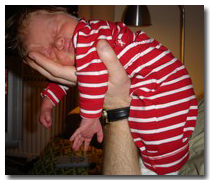
Discover the ancient, world-wide practice of Elimination Communication (EC), and apply it to your modern life. Part-time, with diapers in between potty visits.
EC, or Infant Potty Training, or 'Baby Pottying' is a holistic and cooperative way for you and your baby to gradually and gently reduce the amount of time your baby wears their diapers. I'm meaning on a daily basis, although often babies experiencing use of the potty from a young age also become toilet independent earlier as well.
Less time in a diaper means less risk of diaper rash. Imagine if every baby wore just one less diaper each day?
Unlike Early Toilet Training, EC is about the relationship and communication between you and your baby, and typically begins in infancy, before baby becomes mobile as it is easier then and baby is less diaper dependent.
By Developing Your Diaper-Free Confidence Each Day You Will Open a Door to:
1. Your baby having less time with waste near their skin automatically reduces the risk of rashes because there is less exposure to waste by-products - ammonia and urea.
2. Your baby having less exposure to chemicals in disposable diapers, in wipes, and medications that baby skin may also be sensitive to.
3. A closer insight into how what your baby is eating may be effecting their digestion. Practicing a spot of EC will then give you an insight into what else may be causing or contributing to the diaper rash, so you can eliminate these factors.
4. Enhanced confidence for yourself in meeting the hygiene needs of your in a more natural way.
5. Finding confidence in how to gradually transition to less use of diapers in this alternative to conventional potty or toilet training.
A simple goal is to strive to use just one less diaper each day. Over three years of diapering that is common these days, that means a massive 1000+ less diapers going into landfill, or for you to wash and dry!
I hear you saying: "One less diaper? That's not intimidating! We can do that!"
You're right. One is easy. Save one, go again another day. It's an easy way to begin practicing baby pottying in a gradual, easy way. Part-time EC and Diaper Rash is a useful resource to discover more about using just one less diaper a day.
With some simple skills in EC, you will begin to skip a diaper today, another tomorrow, perhaps a couple the day after that. Some days you'll use the regular amount. Yet, overall, with a potty break simply at diaper changes, some of the diapers your baby wears will stay dry for longer so they can wear them for longer, reducing the number used overall.




























